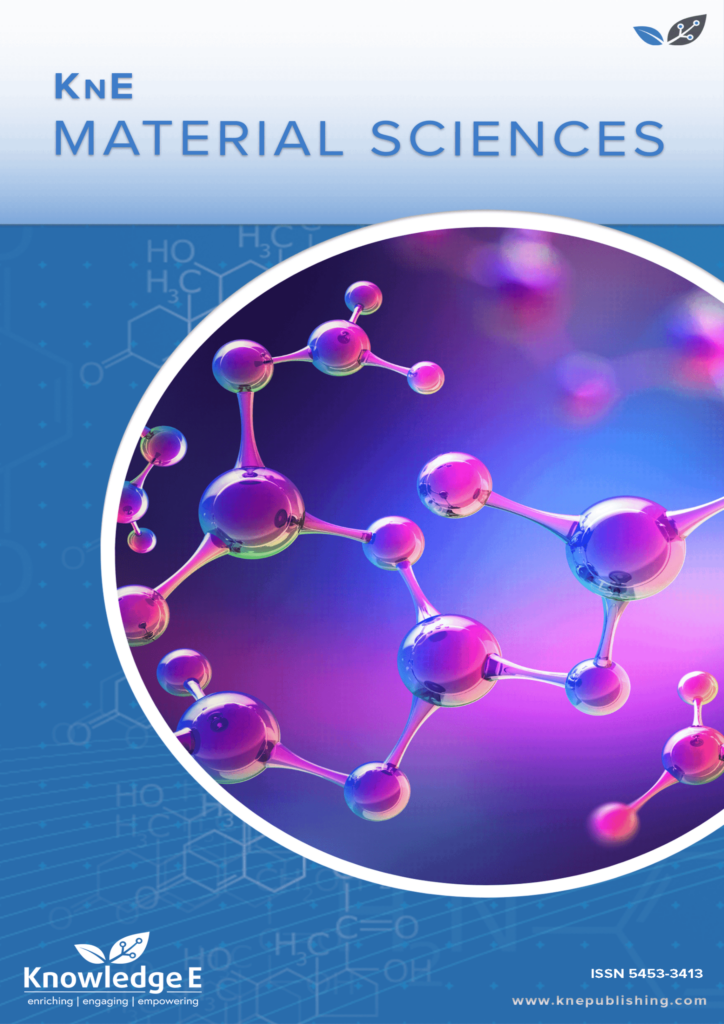
KnE Materials Science
ISSN: 2519-1438
The latest conference proceedings on physical materials, energy materials, electrical materials.
Analysis of Characteristics and Feasibility of High-pressure- and Low-temperature Water Jet Method of Exploiting Marine Natural Gas Hydrate
Published date: Oct 14 2018
Journal Title: KnE Materials Science
Issue title: Sino-Russian ASRTU Conference Alternative Energy: Materials, Technologies, and Devices
Pages: 168-179
Authors:
Abstract:
Marine natural gas hydrate (MNGH) accounts for 99% of the global hydrate resources, 90% of which are deposited in marine clayey silt sediments. MNGH has great economic benefits; however, the large-scale commercial exploitation of hydrates is severely restricted by technology. High-pressure- and low-temperature water jet method is a new kind of MNGH solid exploitation method. This article represents analysis of its characteristics and determination of the critical velocity by laboratory experiment. Results show that the new method is feasible for MNGH exploitation, and the present study can provide reference for subsequent MNGH exploitation research and engineering applications.
Keywords: marine natural gas hydrate, solid exploitation method, high-pressure water jet, critical velocity
References:
[1] Schoderbek, D., Farrell, H., and Howard, J. (2013). ConocoPhillips Gas Hydrate Production Test. NETL and US DOE.
[2] Yousif, M. H., Abass, H. H., Selim, M. S., et al. (1991). Experimental and theoretical investigation of methane-gas-hydrate dissociation in porous media. SPE Reservoir Engineering, vol. 6, no. 1, pp. 69–76.
[3] Chong, Z. R., Yang, S. H. B., Babu, P., et al. (2016). Review of natural gas hydrates as an energy resource: Prospects and challenges. Applied Energy, vol. 162, pp. 1633– 1652.
[4] Max, M. D. and Johnson, A. H. (2016). Exploration and Production of Oceanic Natural Gas Hydrate. Berlin: Springer International Publishing.
[5] Tang, L. G., Li, X. S., Feng, Z. P., et al. (2007). Control mechanisms for gas hydrate production by depressurization in different scale hydrate reservoirs. Energy & Fuels, vol. 21, no. 1, pp. 227–233.
[6] Fan, S., Zhang, Y., Tian, G., et al. (2006). Natural gas hydrate dissociation by presence of ethylene glycol. Energy & Fuels, vol. 20, no. 1, pp. 419–425.
[7] Falser, S., Uchida, S., Palmer, A. C., et al. (2012). Increased gas production from hydrates by combining depressurization with heating of the wellbore. Energy Fuels, vol. 26, no. 10, pp. 6259–6267.
[8] Ruppel, C., Dickens, G. R., Castellini, D. G., et al. (2005). Heat and salt inhibition of gas hydrate formation in the northern Gulf of Mexico. Geophysical Research Letters, vol. 32, no. 4, pp. 353–368.
[9] Ohgaki, K., Takano, K., Sangawa, H., et al. (1996). Methane exploitation by carbon dioxide from gas hydrates – phase equilibria for CO2–CH4 mixed hydrate system. Journal of Chemical Engineering of Japan, vol. 29, no. 3, pp. 478–483.
[10] Demirbas, A. (2010). Methane Gas Hydrate. Berlin: Springer.
[11] Li, X. S., Xu, C. G., Zhang, Y., et al. (2016). Investigation into gas production from natural gas hydrate: A review. Applied Energy, vol. 172, pp. 286–322.
[12] Suzuki, S. and Kuwano, R. (2016). Evaluation on stability of sand control in mining methane hydrate. Production Research, vol. 68, no. 4, pp. 311–314.
[13] Murphy, A., Soga, K., and Yamamoto, K. (2017). A laboratory investigation of sand production simulating the 2013 Daini- Atsumi Knoll gas hydrate production trial using a high pressure plane strain testing apparatus. Proceedings of the 9th International Conferences on Gas Hydrate. Denver, Colorado, USA: ICGH9.
[14] Konno, Y., Oyama, H., Nagao, J., et al. (2010). Numerical analysis of the dissociation experiment of naturally occurring gas hydrate in sediment cores obtained at the eastern Nankai Trough, Japan. Energy Fuels, vol. 24, no. 12, pp. 6353–6358.
[15] Kono, H. O., Narasimhan, S., Song, F., et al. (2002). Synthesis of methane gas hydrate in porous sediments and its dissociation by depressurizing. Powder Technology, vol. 122, no. 2, pp. 239–246.
[16] Castaldi, M. J., Zhou, Y., and Yegulalp, T. M. (2007). Down-hole combustion method for gas production from methane hydrates. Journal of Petroleum Science & Engineering, vol. 56, no. 1, pp. 176–185.
[17] Yezdimer, E. M., Cummings, P. T., and Chialvo A. A. (2002). Determination of the Gibbs free energy of gas replacement in SI Clathrate hydrates by molecular simulation. Journal of Physical Chemistry A, vol. 106, no. 34, pp. 7982–7987.
[18] Dallimore, S. R. and Collett, T. S. (2005). Scientific results from the Mallik 2002 gas hydrate production research well program, Mackenzie Delta, Northwest Territories, Canada. Bulletin of the Geological Survey of Canada, p. 585.
[19] Collett, T. S., Lewis, R. E., Winters, W. J., et al. (2011). Downhole well log and core montages from the Mount Elbert Gas Hydrate Stratigraphic Test Well, Alaska North Slope. Marine & Petroleum Geology, vol. 28, no. 2, pp. 561–577.
[20] Cyranoski, D. (2013). Japanese test coaxes fire from ice. Nature, vol. 496, no. 7446, p. 409.
[21] Zhang, X. H., Xiao-Bing, L. U., and Liu, L. L. (2014). Advances in natural gas hydrate recovery methods. Progress in Geophysics, vol. 29, pp. 858–869.
[22] Dong, H., Wu, K., and Wu, B. (2017). Modular production system with decomposing natural gas hydrate and separating the sediments from NGH slurry on seabed. Proceedings of the 9th International Conference on Gas Hydrates. Denver, Colorado, USA.
[23] Kaisong, W., Tongwei, J., Dong, L., et al. (2017). Research on design of mining tools of marine gas hydrates reservoirs. Mechanical Science and Technology for Aerospace Engineering, vol. 36, no. 2, pp. 225–231.
[24] Zhou, S. W., Chen, W., Li, Q. P., et al. (2017). Research and development of solidstate fluidized test mining technology for deep-water shallow non-diagenetic gas hydrate. China Offshore Oil and Gas, vol. 29, no. 04, pp. 1–8.